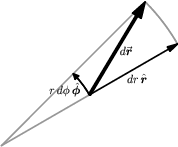Expressing $d\rr$ in Other Coordinate Systems
It is important to realize that $d\rr$ and $ds$ are defined geometrically, not by the component expressions in equations (2) and (3) of § {The Vector Differential}. Because of this coordinate-independent nature of $d\rr$, it is possible and useful to study $d\rr$ in another coordinate system, such as polar coordinates ($r$,$\phi$) in the plane. 1) It is then natural to use basis vectors $\{\rhat,\phat\}$ adapted to these coordinates, with $\rhat$ being the unit vector in the radial direction, and $\phat$ being the unit vector in the direction of increasing $\phi$; see § {Activity: Curvilinear Basis Vectors}. 2)
By determining the lengths of the sides of the infinitesimal polar “rectangle” shown in Figure 1b, one obtains \begin{equation} d\rr = dr\,\rhat + r\,d\phi\,\phat \label{dr2} \end{equation} Notice the factor of $r$ in the $\phat$ term; $d\phi$ by itself is not a length. The length of an infinitesimal arc is $r\,d\phi$. Using Equation (3) of § {The Vector Differential} to find the length of $d\rr$ as before leads to \begin{equation} ds^2 = dr^2 + r^2 \, d\phi^2 \label{ds2} \end{equation} which is the infinitesimal Pythagorean Theorem in polar coordinates.

